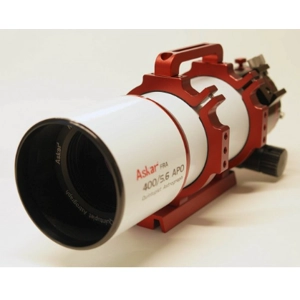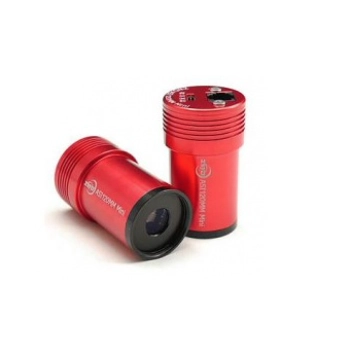
ZWO ASI174MM Mini USB Monochrome Small Format CMOS Camera
Small Format CMOS Camera
This camera is the smaller brother of the popular ASI174MM, but comes in a smaller, lighter format with a 1.25" form factor, with USB2.0 connection instead of USB3.0, it would be a very good alternative for those who don't necessarily need the highest framerate.
When used with smaller guide telescopes this camera will offer an enormous field of view, that combined with the very high sensitivity, makes it a no brainer. You will not suffer from never being able to find a suitable guide star in the field...
It would also make a good guide camera for a very large telescope (with long focal length) with a comparatively large guidescope. Alternatively, due to it's comparatively large sensor it could also serve as a good solar, lunar or planetary imager camera when not used for guiding. It might even bring you some nice deep sky images, but don't forget that this is a monochrome camera...
The ZWO ASI174MM MINI camera integrates Sony IMX174LLJ / IMX174LQJ 1/1.2″ sensor (11.3 mm x 7.1 mm). This is ZWO's first mini camera with a small format, 1.25" nosepiece-style front construction. The camera features 1936 x 1216 pixels. The pixel size large at 5.86 μm x 5.86 μm. This camera provides 12bit ADC and its peak QE is 77%
SPECIFICATIONS
Sensor: 1/1.2″ CMOS IMX174LLJ / IMX174LQJ
Resolution: 2.3Mega Pixels 1936×1216
Pixel Size: 5.86µm
Exposure Range: 32µs-300s
ROI: Supported
Interface: USB2.0
Bit rate: 12bit output(12bit ADC)
Adaptor: 1.25″ / M28.5X0.6
Dimension: φ36mm X 61mm
Weight: 140g
Working Temperature: -5°C—45°C
Storage Temperature: -20°C—60°C
Working Relative Humidity: 20%—80%
Storage Relative Humidity: 20%—95%
12bit
1936*1216 18.4fps
Astrophotography Performance
The ZWO ASI174 ini camera offers you very good performance for planetary, solar, lunar imaging and guiding. Low read noise, high dynamic range, QE peak 77%, AR protective window and much more High Sensitivity.
Sensitivity is the first thing we considered. It's very important to find a guide star. So for start, we were considering using only a mono sensor to design our guide camera, because a mono sensor has much higher sensitivity than color ones. After that, we carefully compared the sensitivity of our sensors.
At last, we decide to use 290 and 174 mono sensor. As we know, 290 and 174 mono sensors have about 80% peak QE, so these can detect more stars in the field of view. Also, we can shorten the exposure time in guiding that might make guiding more precise.

 GBP
GBP AED
AED AFN
AFN ALL
ALL AMD
AMD ANG
ANG AOA
AOA ARS
ARS AUD
AUD AWG
AWG AZN
AZN BAM
BAM BBD
BBD BDT
BDT BGN
BGN BHD
BHD BIF
BIF BMD
BMD BND
BND BOB
BOB BRL
BRL BSD
BSD BTN
BTN BWP
BWP BYN
BYN BZD
BZD CAD
CAD CDF
CDF CHF
CHF CLF
CLF CLP
CLP CNH
CNH CNY
CNY COP
COP CRC
CRC CUC
CUC CUP
CUP CVE
CVE CZK
CZK DJF
DJF DKK
DKK DOP
DOP DZD
DZD EGP
EGP ERN
ERN ETB
ETB EUR
EUR FJD
FJD FKP
FKP GEL
GEL GGP
GGP GHS
GHS GIP
GIP GMD
GMD GNF
GNF GTQ
GTQ GYD
GYD HKD
HKD HNL
HNL HRK
HRK HTG
HTG HUF
HUF IDR
IDR ILS
ILS IMP
IMP INR
INR IQD
IQD IRR
IRR ISK
ISK JEP
JEP JMD
JMD JOD
JOD JPY
JPY KES
KES KGS
KGS KHR
KHR KMF
KMF KPW
KPW KRW
KRW KWD
KWD KYD
KYD KZT
KZT LAK
LAK LBP
LBP LKR
LKR LRD
LRD LSL
LSL LYD
LYD MAD
MAD MDL
MDL MGA
MGA MKD
MKD MMK
MMK MNT
MNT MOP
MOP MRU
MRU MUR
MUR MVR
MVR MWK
MWK MXN
MXN MYR
MYR MZN
MZN NAD
NAD NGN
NGN NIO
NIO NOK
NOK NPR
NPR NZD
NZD OMR
OMR PAB
PAB PEN
PEN PGK
PGK PHP
PHP PKR
PKR PLN
PLN PYG
PYG QAR
QAR RON
RON RSD
RSD RUB
RUB RWF
RWF SAR
SAR SBD
SBD SCR
SCR SDG
SDG SEK
SEK SGD
SGD SHP
SHP SLE
SLE SLL
SLL SOS
SOS SRD
SRD SSP
SSP STD
STD STN
STN SVC
SVC SYP
SYP SZL
SZL THB
THB TJS
TJS TMT
TMT TND
TND TOP
TOP TRY
TRY TTD
TTD TWD
TWD TZS
TZS UAH
UAH UGX
UGX USD
USD UYU
UYU UZS
UZS VES
VES VND
VND VUV
VUV WST
WST XAF
XAF XCD
XCD XCG
XCG XOF
XOF XPF
XPF YER
YER ZAR
ZAR ZMW
ZMW ZWG
ZWG ZWL
ZWL UK English
UK English Swedish
Swedish Spanish
Spanish Norwegian
Norwegian Dutch
Dutch German
German Arabic
Arabic


















